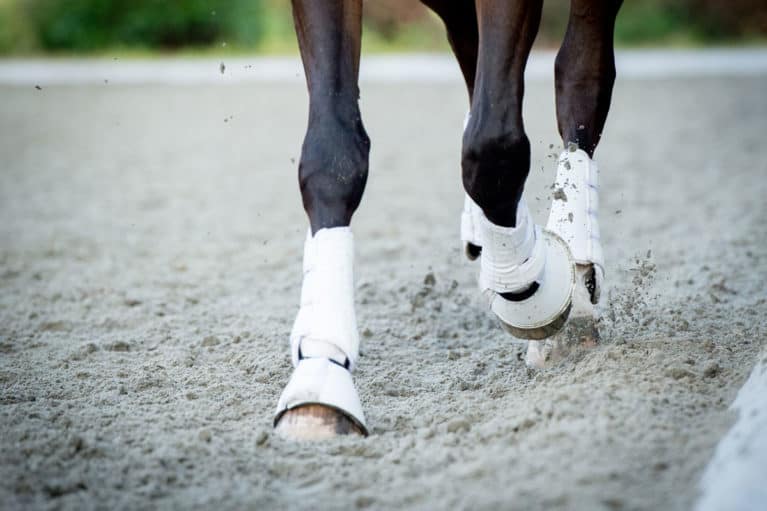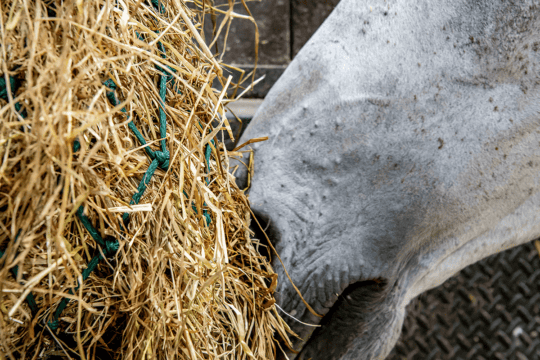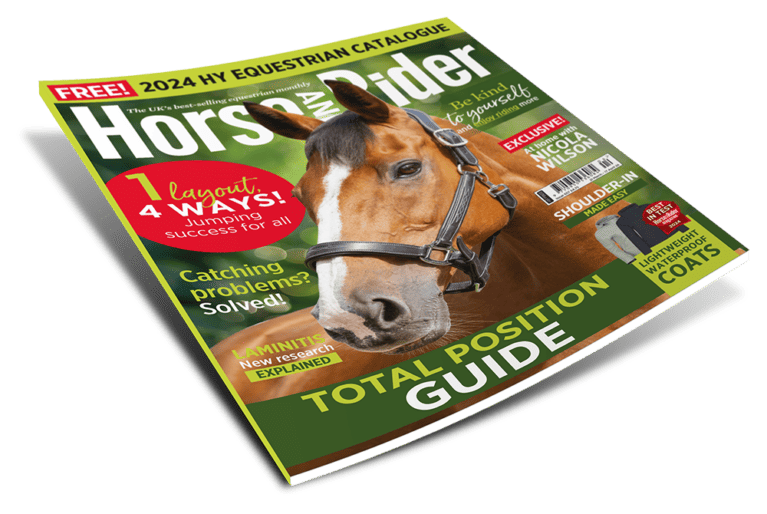Suspensory injuries are notoriously difficult to heal successfully, but there could be a new treatment on the horizon, as vet Dr Sue Dyson from the Animal Health Trust explains
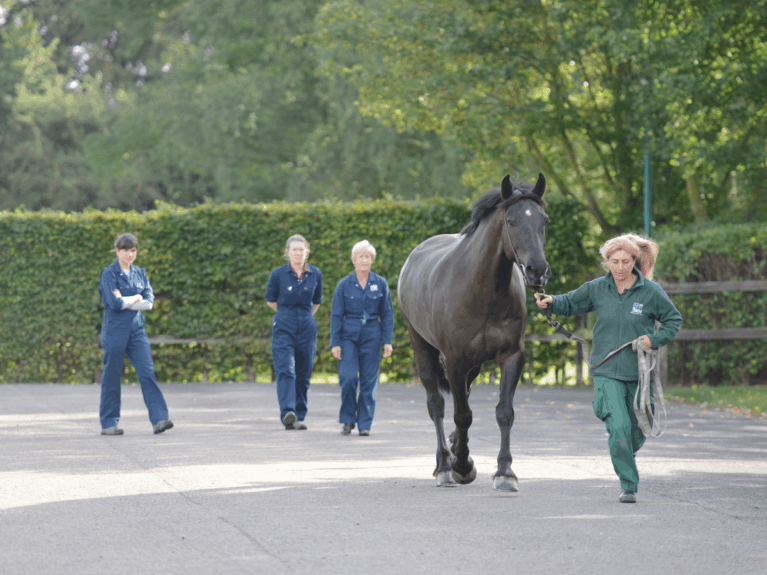
Any injury to your horse is devastating, but particularly a diagnosis of suspensory ligament injury, because they often take a long time to heal and can be prone to reinjury. How well your horse will recover from suspensory damage depends on which part of the ligament is injured and how bad the damage is, but severe injuries are often career limiting. However, if you’re clued up on signs of potential injury and can target a problem early, the chances of your horse making a good recovery are significantly increased.
Where is the suspensory ligament?
It sits at the back of the leg and starts at the top of the cannon bone in both the forelegs and hindlegs. About two thirds of the way down the cannon bone, it divides into two branches that run to the inside and outside sesamoid bones.
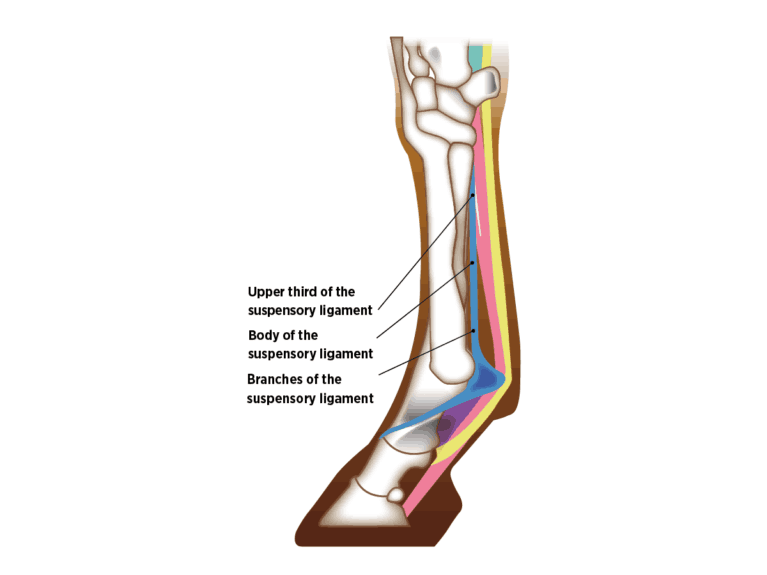
Different types of injury
Suspensory ligament injuries fall into three main categories, depending on the area that’s injured…
- the upper third of the ligament, which is known as proximal suspensory desmopathy (PSD) and may include damage where the ligament attaches to the cannon bone
- the body of the ligament, which is the middle third of the suspensory ligament
- the branches, which can involve a small lesion that’s contained locally or more widespread tears. These injuries may also include damage where the ligament attaches to the sesamoid bones
There’s a close relationship between the branches and the splint bones, and with some injuries there may also be a fracture of the lower part of the bone. The fetlock joint is sometimes involved, too, and enlargement of the joint capsule with excess synovial fluid may indicate tearing of fibres involving the joint.
PSD and injuries to the branches are common in sports and leisure horses, and may occur in one or both forelimbs, or one or both hindlimbs. These injuries may be the result of a single traumatic event – for example, a horse jumping onto the side of a bank and pulling a front shoe off, resulting in abnormal loading of the suspensory ligament – or due to repetitive overload.
Injury to the body of the ligament is unusual in sports and leisure horses, although it can occur as a result of PSD or branch injuries. Suspensory body injuries are usually seen in racehorses.
Who’s at risk?
Suspensory injury is a common cause of lameness in all types of horse, however there are certain risk factors…
- young, extravagant-moving horses who lack strength and co-ordination may be more at risk of forelimb PSD than older, stronger, better balanced horses
- upper level dressage horses are particularly prone to hindlimb PSD
- straight hock conformation
- excessive extension (sinking) of the fetlocks
- foot imbalance
- inconsistent work surfaces
- fatigue
Occasionally, young horses develop suspensory injuries in more than one limb, despite having done little work. These horses may be genetically predisposed to injury.
Signs of injury
The signs of a suspensory injury depend on which part of the ligament is injured, but there are a few things to look out for…
- heat and swelling A recent injury may cause heat at the site of injury, pain and swelling. However, with PSD, because the suspensory ligament lies against the back of the cannon bone and is overlaid by the check ligament and flexor tendons, these signs are difficult to detect. When the body of the ligament is damaged, the swelling is obvious. Swelling on the inside or outside of the fetlock is a sign of a possible branch injury, and when firm pressure is applied to the branch and the fetlock is flexed, it may cause pain.
- inconsistent ligament thickness In a normal horse who is standing bearing even weight, the front and back edges of the suspensory body and branch should be parallel. This can be assessed by facing the side of your horse’s leg, placing your thumbs on the sides of the ligament and running them down his leg – they should remain equidistant. If they get pushed further apart in the lower part of the limb, this usually reflects enlargement of the branch.
- lameness With PSD there’s usually lameness, or reduced step length or lack of hindlimb impulsion if both forelimbs or both hindlimbs are affected, and when both hindlegs are injured, horses may become unwilling to work.
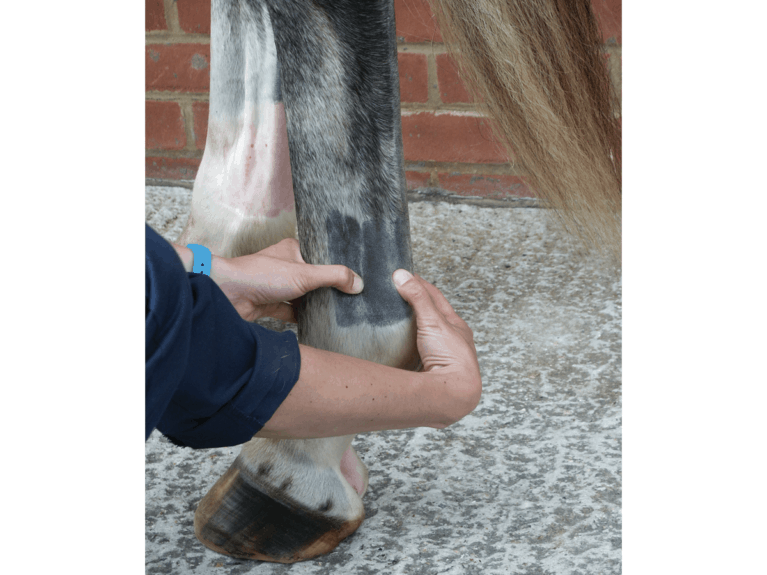
Forelimb PSD is usually characterised by a lameness that’s at its worst when the affected limb is on the outside of a circle on a soft surface. In the early stages, the lameness may improve quickly with rest, but recur when work is resumed. Branch injuries and hindlimb injuries have less consistent patterns of lameness.
Branch injuries can occur without detectable lameness in some horses, but in other horses the lameness is obvious. However, when the body of the ligament is injured, lameness is usually clear to see.
Pinpointing the problem
Because there are often no definitive signs, your vet will need to perform nerve blocks to determine the source of the pain. Once the area has been pinpointed, it can be assessed using ultrasound and X-rays. If the severity of the lameness is disproportionate to the amount of ligament damage identified on the ultrasound scan, it may be necessary to perform a bone scan or MRI to check the cannon bone hasn’t been damaged where the ligament attaches to it. If it has, the injury will normally take longer to heal.
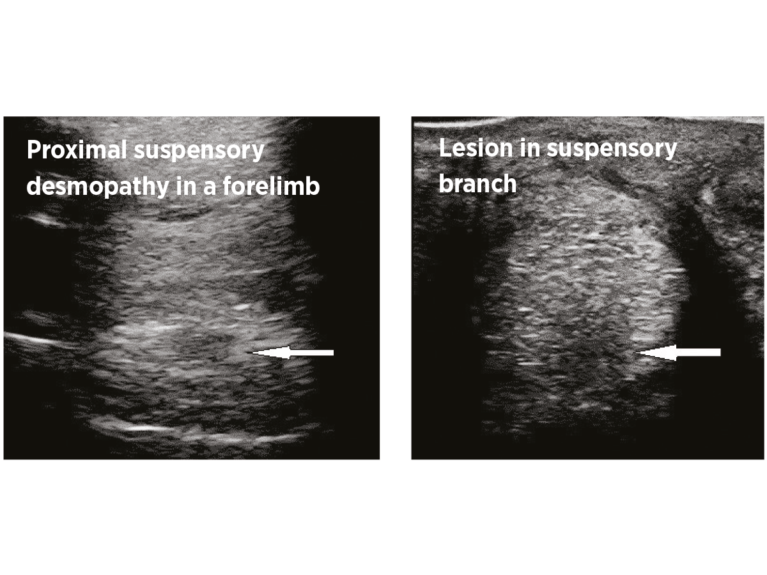
Tailored treatment plans
Treatment for suspensory injuries varies depending on the type of injury your horse has sustained…
- forelimb PSD A new injury usually responds well to rest for a minimum of three months. This involves box rest and controlled walking exercise. It’s also crucial that your horse’s feet are trimmed and shod appropriately to ensure they’re correctly balanced and to ease breakover (the point where your horse’s heel lifts and pivots over his toe during movement).
Chronic injuries don’t respond well to rest alone, so shockwave therapy or radial pressure wave therapy are sometimes used to help healing. Stem cell therapy and platelet-rich plasma (PRP) are other potential treatment options, although in my experience, cultured mesenchymal stem cells have resulted in superior results compared to PRP.
- hindlimb PSD is usually a degenerative injury and the response to rest alone or combined with shockwave therapy is often disappointing. Surgery usually achieves the best results, with approximately 78% of horses suitable for surgery returning to full athletic function. However, this option isn’t appropriate for horses with poor hindlimb conformation because they may develop ongoing degeneration of the suspensory ligament and worsening lameness.
The operation involves cutting the main nerve to the ligament (neurectomy), and cutting the band of tissue that squashes the ligament between the back of the cannon bone and the splint bones (fasciotomy). However, a perfect cosmetic outcome can’t be guaranteed – some horses have a small curb-like swelling at the surgical site and sometimes a few white hairs. The length of recovery after surgery depends on the severity of the injury, but most are able to begin ridden work after two months, while more severe cases can take 6–9 months.
- branch injuries If the fetlock has been involved in the injury, surgery may be necessary, although most branch injuries won’t require an operation. Small injuries may heal with box rest and controlled walking exercise. However, large lesions, particularly those that involve attachment to the cannon bone, are much more challenging to manage successfully. There is currently little evidence-based information that cultured mesenchymal stem cells or PRP are effective treatments for this type of injury.
Some horses develop a thick rim of fibrous tissue around the injured branch that can itself be prone to repetitive tearing and these cases are particularly challenging to manage. There is some unpublished anecdotal information from the USA that the use of a high-frequency laser may be helpful in this instance. The Animal Health Trust has just acquired such a laser, but it will take several years before we know how effective it is.
Catching it early is key
As with any soft tissue injury, recognising the problem early and treating it appropriately is the key to successful management. This is because if injuries go unrecognised, other problems may develop, which can hinder your horse’s chances of recovery – for example, a proportion of horses who’ve had PSD in their hindleg for a while develop pain in the sacroiliac region, which can become a limiting factor for future performance.
In addition, the Animal Health Trust has recently reported on a group of horses who had injuries of the top of the check ligament on the back of the knee, which were associated with PSD. It’s thought that these check ligament injuries occurred as a result of the PSD. So far, these horses have responded much less well to treatment, emphasising the need for early diagnosis and appropriate treatment.
The Animal Health Trust has also recently recognised a group of horses who sustained injury to the accessory ligament of the suspensory ligament in association with PSD. The accessory ligament attaches the suspensory ligament to the back of the knee and hock. It’s believed that these injuries are also likely to be as a result of pre-existing PSD.
Protecting the suspensory ligament
Suspensory ligament injuries are tough to prevent, but there are a number of things that will help lower the risk…
- fitness Your horse should always be fit enough for the work you’re asking him to perform
- surface variety He should be worked on a variety of different surfaces to help condition the ligaments
- work variety Adding variety to your horse’s work is also important to reduce the risk of repetitive overload
- paces Collected and extended paces are more demanding on the suspensory ligaments compared with working paces, so it’s important not to overuse them
- farriery Regular trimming and shoeing (every five weeks) will optimise foot balance
- correct work Working your horse in a way that develops his key core muscles and improves his posture is an important part of injury prevention
- conformation When buying a horse, choosing one with good conformation is particularly important to reduce the risk of injury in the hindlimbs – a hock angle of greater than 165° should be avoided. It’s also wise to avoid horses whose fetlocks sink excessively during motion
In a nutshell
Taking steps to help lower the risk of suspensory injury will always be beneficial and it could help prevent many other types of injury, too. But the most important thing is to be able to recognise when an injury has occurred so it can be treated promptly, as this is crucial for successful healing.
While recent PSD injuries in the forelimb can be managed with a relatively low risk of recurrence, injuries to the branches of the suspensory ligament can be much more challenging. However, it’s hoped that the new high-frequency laser treatment might be the way forward, offering hope to horses with career-limiting injuries.




